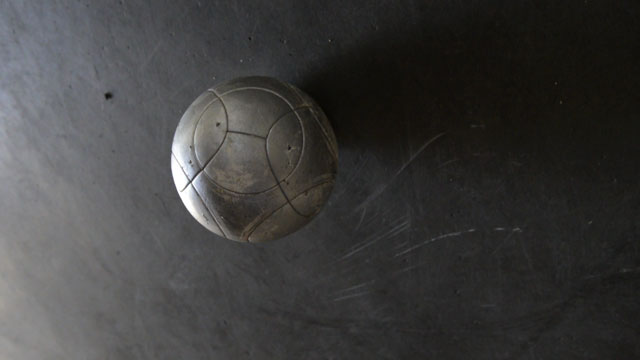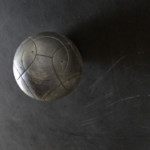Exhibition
in Biel/Bienne / Switzerland
- Livia Di Giovanna: Silberball, 2017, Video, 7’53”, Courtesy the artist
- Livia Di Giovanna: Ufer, 2017, 16 Videos mit Audio auf 16 Monitoren, Loop (8 – 12′), Courtesy the artist
- Livia Di Giovanna: Prototyp, 2017, MDF, Melaminharzbeschichtung weiss, 182 x 165 x 80 cm, Courtesy the artist
Livia Di Giovanna’s (b. 1984, CH) video installations, photographs and objects subtly eliminate the boundaries between reality, projection and reflexion. Her investigations of space, time, architecture, movement and light are based on decisions concerning dimensions, scale and volume, the production and direction of light, the character of surfaces and spatial relationships. In her earlier works she focused primarily on the physical and technical characteristics of her chosen materials rather than engaging in narrative allusions or representations of the external world. In contrast, the two new video installations produced especially for this exhibition demonstrate the artist’s interest in the connection between the real and the imaginary by subtly deconstructing subject matter from her environment. When Livia Di Giovanna demonstrates the surreal and strange in apparently normal areas of the real world it becomes apparent which aspect is central in these works: the investigation of the medium of video itself. The exhibition marks Livia Di Giovanna’s receipt of the Manor Art Prize 2016 for the Canton of Bern and is her most comprehensive solo show to date.
The two new video installations “Ufer” (2017) and “À l’intérieur” (2017) that Livia Di Giovanna has produced among others for the exhibition at the Kunsthaus Pasquart are a further development of her engagement with the conditions of the medium. Although both works combine the moving image, a visualisation of the passing of time and the relationship between light and movement, they are less abstract than previous pieces, each of them based on the recording of a real situation. The video “Ufer” consists of a 12-metre-long row of 16 abutting monitors. It shows a flowing river, recorded section by section, accompanied by 16 sounds of rushing water. Although the artist connected the fragments as accurately as possible to convey the initial impression of a single recording, this is swiftly disrupted by the realisation that the individual shots were taken at different times and are therefore unsynchronised.
Di Giovanna sets up a dialogue between her objects and their environment. Her precisely angled installations of film projections and three-dimensional geometric objects cleverly eliminate the boundaries between reality, projection and reflexion, while sculptural works that include glass and mirrors juxtapose and fuse reflections of both themselves and their environment. For example, “Offroader” (2014), a wooden wheel placed stationary on the floor, recalls a disused piece of apparatus from an observatory or the central fixture for a roll of film, the work’s reflection of its surroundings suggesting that a new future function is possible. Similarly, a new work, “Ohne Titel” (2017) shows a converted table and refers to the conditions of film and photography by suggesting a potential piece of projection equipment or recalling a Camera Obscura.
It is the inherent properties of her materials, as well as their potential, alone or in combination, to create space, that Di Giovanna is interested in exploring. The recent video showing a plumb bob spinning on its own axis, “Lot” (2017), transforms the circular movement determined by the form and weight of a simple object into an essentially sculptural experience. In a kind of reverse process, the video “Silberball” (2017) was made by the camera turning slowly around all sides of a ball lying on the floor. The varying tempo of the rubber ball in “Ohne Titel” (2013) produces a moving line drawing rather than a sculpture.
Light lies at the heart of Di Giovanna’s investigation of how materials interact with each other, respond to movement or are captured by the camera. Not only are light sources and reflections on various surfaces a consistent feature of her videos, but light as an autonomous entity is frequently the central theme, for example the constantly changing form of the plastic bag, filled with air, in the video “Ohne Titel” (2012). Di Giovanna’s experiments with overhead projectors further reduce the components she needs to make art. “Ohne Titel” (2011) consists of an overhead projector used to project a glass bottle onto a wall. Whereas this process is logical in the case of script or drawings, when used to transform a three-dimensional object into a flat image, the dimensions, proportions and even colour of the original are oddly distorted. The immateriality of the projection in this work is wittily turned into material in “Ohne Titel” (2009), in which a large rectangle of white paint applied to the wall simulates an empty projection surface. The narrow bands of colour that edge the white emphasise the impression of the empty space as imperfectly projected light.
In Di Giovanna’s other new installation for the exhibition, “À l`intérieur”, the ways in which reality is recorded and communicated are much less tangible, placing our perception fundamentally in question. In total darkness, with the only light emitting from a pocket torch to make isolated objects or details of the space visible momentarily, the artist filmed the interior of her studio. In the equally blacked-out exhibition space, the film is projected in a double 16:9 format. In spite of the one-to-one scale relationship established between the projected room, the real room and the observer, the most basic of objects appear strange and unfamiliar. Since the space can never be seen as a whole, it is only in the imagination of the observer that it can become an entity.
Curator of the exhibition: Felicity Lunn, Director Kunsthaus Pasquart
The exhibition is accompanied by a richly illustrated publication with texts by Felicity Lunn and Ulrich Loock, Verlag für moderne Kunst (DT / FR / ENG).
Opening hours Wed-Fri noon – 6 pm, Thur noon – 8 pm, Sat/Sun 11 am – 6 pm
Die Videoinstallationen, Fotografien und Objekte von Livia Di Giovanna (*1984, CH) heben subtil die Grenzen zwischen Realität, Projektion und Reflexionen auf. Ihre Untersuchungen von Raum, Zeit, Architektur, Bewegung und Licht stützen sich auf Entscheidungen über Dimensionen, Volumen, Oberflächenbeschaffenheit, Lichterzeugung und -führung. In ihren früheren Werken fokussierte sie sich eher auf die physischen und technischen Merkmale ihrer Materialien, als sich mit narrativen Andeutungen oder Darstellungen der äusseren Welt zu befassen. Zwei neue Videoinstallationen hingegen, welche insbesondere für diese Ausstellung entstanden, zeugen vom Interesse an der Verbindung zwischen dem Realen und dem Imaginären, indem die Künstlerin Inhalte aus ihrem Lebensumfeld raffiniert dekonstruiert. Wenn die Künstlerin das Surreale und Fremde in scheinbar belanglosen Facetten der wirklichen Welt nachweist, wird offensichtlich, welcher Aspekt in diesen Werken zentral ist: die Untersuchung des Mediums Video an sich. Die Ausstellung von Livia Di Giovanna findet anlässlich der Verleihung des Manor Kunstpreises 2016 für den Kanton Bern statt und ist ihre bisher umfassendste Einzelausstellung.
Die beiden neuen Videoinstallationen “Ufer” (2017) und “À l’intérieur” (2017), welche die Künstlerin neben anderen Werken für die Ausstellung im Kunsthaus Pasquart realisiert hat, verweisen auf eine vertiefte Auseinandersetzung mit den Charakteristiken ihres Mediums. Beide Arbeiten verbinden das Bewegtbild mit einer Visualisierung der fortschreitenden Zeit und der Beziehung zwischen Licht und Bewegung. Dennoch sind sie weniger abstrakt als vorangegangene Videos, da sie Aufnahmen einer realen Situation wiedergeben. Das Video “Ufer” besteht aus einer zwölf Meter langen Reihe von sechzehn nebeneinanderhängenden Monitoren. Zu sehen ist ein strömender Fluss und ein schmaler Streifen des gegenüberliegenden Ufers, Abschnitt für Abschnitt gefilmt und begleitet von sechzehn Geräuschen fliessenden Wassers. Die Fragmente wurden so genau wie möglich zusammengefügt, um den Eindruck einer einzigen Aufnahme zu vermitteln, dieser wird jedoch schnell durch die Erkenntnis gebrochen, dass die einzelnen Einstellungen zeitversetzt aufgezeichnet wurden und daher nicht synchron sind. Da das Dargestellte deutlich erkennbar ist, verbindet der Betrachter die einzelnen Abschnitte gedanklich, um das Bild als Einheit wahrnehmen zu können. Es ist eben diese Ambivalenz im Wahrnehmungsprozess sowie die gleichzeitige Bewegung des filmischen Bildes und diejenige des Betrachters beim Auf- und Abgehen vor der Arbeit, die Livia Di Giovanna interessieren.
Die Künstlerin inszeniert einen Dialog zwischen den Objekten und ihrer Umgebung. Ihre Installationen aus Filmprojektionen und dreidimensionalen geometrischen Objekten stehen in einem präzisen Winkel zueinander und verwischen geschickt die Grenzen zwischen Wirklichkeit und filmischer Repräsentation. Skulpturale Arbeiten dagegen, die Glas und Spiegel einschliessen, verbinden Reflexionen von sich selbst als auch ihrer Umgebung und lassen sie ineinander übergehen. “Offroader” (2014), ein auf dem Boden liegendes Holzrad, erinnert beispielsweise an ein ausgedientes Teil eines Gerätes aus einer Sternwarte oder an die Mittelschraube einer Filmrolle. Die Art und Weise, wie die Arbeit die Umgebung widerspiegelt, suggeriert, dass eine alternative zukünftige Verwendung möglich ist. Vergleichbar zeigt das neue Werk “Prototyp” (2017) einen transformierten Tisch und verweist auf die Eigenschaften von Film und Fotografie, indem sie an eine Camera obscura erinnert.
Di Giovannas Interesse gilt den Materialien innewohnenden Eigenschaften sowie ihrem Potenzial, Raum zu erzeugen. In dem aktuellen “Video Lot” (2017), das ein sich um seine eigene Achse drehendes Senklot zeigt, wird die durch Form und Gewicht des einfachen Objekts bestimmte Kreisbewegung als Skulptur erfahrbar. In einem gewissermassen umgekehrten Prozess entstand das Video “Silberball” (2017), indem die Kamera sich langsam um alle Seiten eines am Boden liegenden Balls drehte. Das wechselnde Tempo eines Gummiballes in “Ohne Titel” (2013) bringt hingegen keine Skulptur, sondern eher eine sich bewegende Linienführung hervor.
Licht spielt eine wesentliche Rolle, wenn Di Giovanna zu ergründen sucht, wie Materialien interagieren, auf Bewegung reagieren oder von der Kamera erfasst werden. Nicht nur Lichtquellen und Reflexionen auf unterschiedlichen Oberflächen sind ein konstantes Merkmal ihrer Videos, auch Licht als autonome Einheit wird immer wieder zum zentralen Thema. So zum Beispiel die sich ständig verändernde Form des mit Luft gefüllten Plastikbeutels im Video “Ohne Titel” (2012). Di Giovannas Experimente mit Hellraumprojektoren reduzieren das Repertoire der von ihr benötigten Komponenten, um Kunst zu machen, noch weiter. “Ohne Titel” (2011) besteht aus einem Hellraumprojektor, über welchen eine Glasflasche auf eine Wand projiziert wird. Auch wenn dieses Verfahren im Falle von Text oder Zeichnungen sinnvoll sein mag, wirken die Dimensionen, Proportionen und sogar die Farbe des Originals seltsam verfälscht, da hier ein dreidimensionales Objekt in ein zweidimensionales Bild verwandelt wird. Die Immaterialität der Projektion in dieser Arbeit wird in “Ohne Titel” (2009) auf geistreiche Weise in Material verwandelt: Ein auf eine Wand gemaltes weisses Rechteck simuliert hier eine leere Projektionsfläche. Die schmalen Farbbänder, die an den Rändern des weissen Rechtecks entlanglaufen, verstärken den Eindruck, dass es sich bei diesem Leerraum um unvollkommen projiziertes Licht handelt.
In “À l’intérieur”, der zweiten neuen Installation, ist die Art und Weise wie Realität aufgezeichnet und vermittelt wird so wenig fassbar, dass wir unsere Wahrnehmung grundlegend in Frage stellen. In absoluter Dunkelheit und nur mit dem Licht einer Taschenlampe, durch das einzelne Objekte oder Details des Raumes für einen kurzen Augenblick sichtbar werden, hat die Künstlerin den Innenraum ihres Ateliers gefilmt. Im gleichermassen abgedunkelten Ausstellungsraum werden die beiden Projektionen nebeneinander in einer Gesamtgrösse von 11 x 3.1 Meter projiziert. Trotz des originalgetreuen Verhältnisses zwischen dem projizierten Raum, dem realen Raum und dem Betrachter erscheinen ganz gewöhnliche Objekte eigenwillig und ungewohnt. Da der Raum niemals vollständig sichtbar wird, verbindet er sich nur in der Vorstellung des Betrachters zu einer gedanklichen Einheit.
Kuratorin der Ausstellung: Felicity Lunn, Direktorin Kunsthaus Pasquart
Zur Ausstellung erscheint eine reichbebilderte Publikation mit Texten von Felicity Lunn und Ulrich Loock im Verlag für moderne Kunst (DT / FR / ENG).
Öffnungszeiten Mi-Fr 12 – 18 Uhr, Do 12 – 20 Uhr, Sa/So 11 – 18 Uhr
Location:
Kunsthaus Centre d’art Pasquart
Seevorstadt 71 Faubourg du Lac
2502 Biel/Bienne
Switzerland




